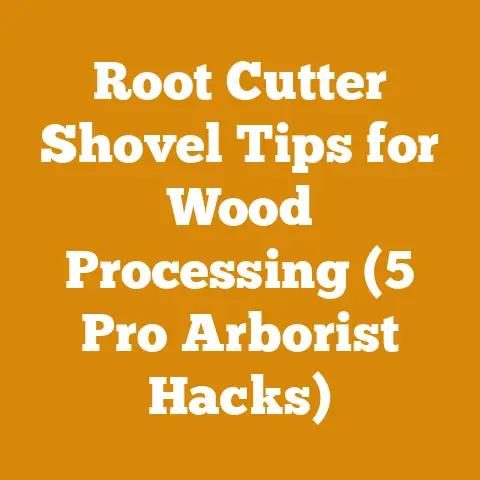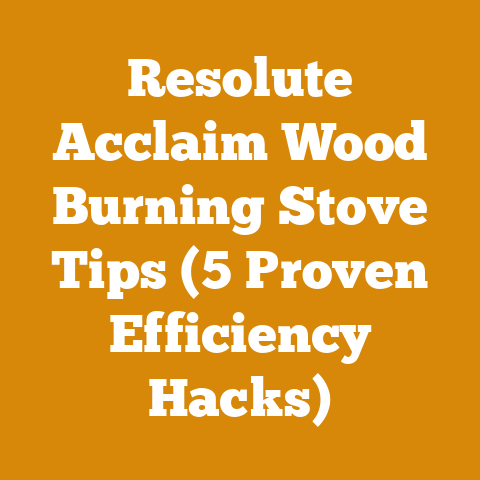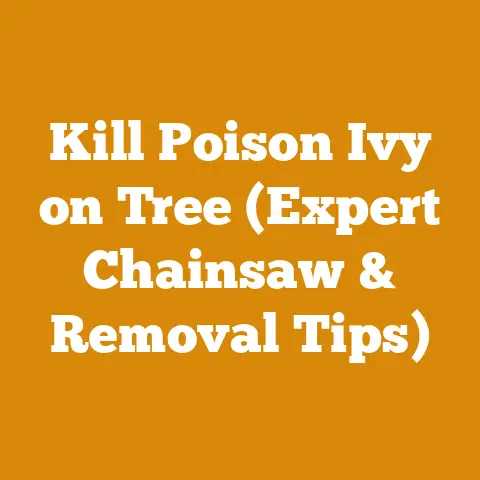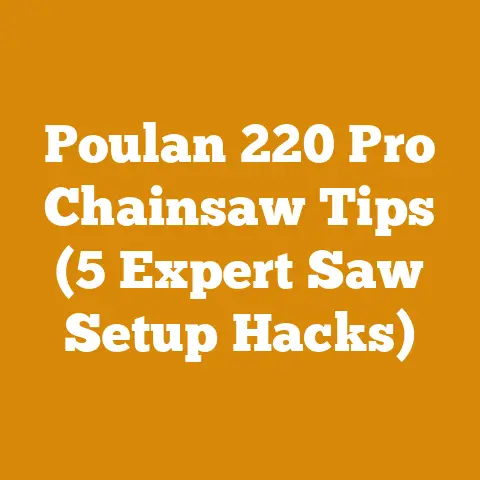JB Weld for Mufflers: Durable Fixes on Chainsaws (Pro Repair Tips)
Introduction: The Surprisingly Clean World of Chainsaw Muffler Repair
One of the often-overlooked aspects of chainsaw maintenance is the surprisingly clean nature of muffler repair, especially when compared to other tasks like cleaning a bar or replacing a chain.
While the work environment might be dusty and filled with wood chips, repairing a muffler, especially with JB Weld, can be a relatively tidy process.
This is because you’re often dealing with metal surfaces that can be easily wiped down and prepped for adhesive application.
Understanding the Chainsaw Muffler
Before diving into repairs, let’s understand what a muffler does and why it’s crucial.
What is a Chainsaw Muffler?
A chainsaw muffler, also sometimes called an exhaust, is a component designed to reduce the noise produced by the engine’s exhaust gases and direct those gases away from the operator.
It also contains a spark arrestor screen to prevent hot particles from exiting the exhaust and potentially igniting dry vegetation, which is a significant fire hazard, especially in dry environments.
Why is the Muffler Important?
The muffler serves several critical functions:
- Noise Reduction: Chainsaws are inherently loud machines.
The muffler significantly reduces the noise level, making the work environment more bearable and complying with noise regulations.
I’ve personally experienced the difference between a chainsaw with a properly functioning muffler and one without.
The noise reduction is substantial.
A chainsaw without a muffler can easily exceed 110 decibels, causing hearing damage with prolonged exposure. - Spark Arresting: The spark arrestor screen is vital for preventing wildfires.
It catches hot particles that could potentially ignite dry leaves, grass, or other flammable materials.
In many areas, operating a chainsaw without a functioning spark arrestor is illegal and carries hefty fines. - Engine Performance: A properly functioning muffler contributes to optimal engine performance.
A damaged or clogged muffler can restrict exhaust flow, leading to reduced power, increased fuel consumption, and potential engine overheating. - Safety: A damaged muffler can expose the operator to hot exhaust gases and increase the risk of burns.
Common Causes of Muffler Damage
Mufflers are subjected to harsh conditions, including high temperatures, vibrations, and physical impacts.
Common causes of damage include:
- Corrosion: Exposure to moisture and exhaust gases can cause rust and corrosion, weakening the metal over time.
This is especially prevalent in older chainsaws or those used in humid environments. - Cracks: Vibrations and stress can lead to cracks, particularly around welds or mounting points.
- Impact Damage: Accidental impacts with rocks, trees, or other objects can dent or puncture the muffler.
I once damaged a muffler by accidentally dropping a log directly onto it.
It created a significant dent and a small crack. - Clogging: Carbon buildup from exhaust gases can clog the muffler, restricting airflow and reducing engine performance.
This is more common with chainsaws that use low-quality fuel or oil.
JB Weld: A Durable Solution for Muffler Repairs
JB Weld is a two-part epoxy adhesive known for its strength, durability, and resistance to high temperatures.
It’s a popular choice for repairing metal components, including chainsaw mufflers.
What is JB Weld?
JB Weld is a thermosetting polymer compound typically sold as a two-part epoxy system.
When mixed, the resin and hardener chemically react to form a strong, rigid bond.
There are different types of JB Weld, each with varying properties.
For muffler repairs, I recommend using JB Weld Original or JB Weld ExtremeHeat, as these are specifically formulated for high-temperature applications.
Why Use JB Weld for Muffler Repairs?
JB Weld offers several advantages for repairing chainsaw mufflers:
- High-Temperature Resistance: JB Weld Original can withstand temperatures up to 500°F (260°C), while JB Weld ExtremeHeat can handle even higher temperatures, up to 2400°F (1300°C) for intermittent use.
This makes it suitable for the high-temperature environment of a chainsaw muffler. - Strength and Durability: JB Weld creates a strong, durable bond that can withstand vibrations and stress.
- Easy to Apply: JB Weld is relatively easy to apply, even for beginners.
It can be shaped and molded to fill gaps and cracks. - Cost-Effective: Repairing a muffler with JB Weld is significantly cheaper than replacing it.
A new muffler can cost anywhere from $30 to $100 or more, while a tube of JB Weld typically costs around $10 to $20. - Versatility: JB Weld can be used to repair a variety of muffler damages, including cracks, holes, and dents.
Limitations of JB Weld Repairs
While JB Weld is a valuable tool for muffler repairs, it’s essential to understand its limitations:
- Not a Permanent Solution: JB Weld repairs are generally considered temporary fixes.
While they can last for a considerable time, they may eventually fail due to continued exposure to high temperatures and vibrations. - Surface Preparation is Crucial: The success of a JB Weld repair depends heavily on proper surface preparation.
The surfaces must be clean, dry, and free of rust or grease. - Not Suitable for Severely Damaged Mufflers: JB Weld is not a suitable solution for severely damaged mufflers with large holes or extensive corrosion.
In such cases, replacing the muffler is the best option. - Welding is Stronger: A professional weld will always be a stronger and more durable repair than JB Weld.
However, welding requires specialized equipment and skills, making JB Weld a more accessible option for many users.
Step-by-Step Guide to Repairing a Chainsaw Muffler with JB Weld
Now, let’s get into the practical steps of repairing a chainsaw muffler with JB Weld.
Tools and Materials Needed
Before you start, gather the following tools and materials:
- JB Weld Original or JB Weld ExtremeHeat: Choose the appropriate type of JB Weld based on the expected operating temperature of your chainsaw muffler.
- Safety Glasses: Protect your eyes from debris and chemicals.
- Gloves: Protect your hands from JB Weld and sharp edges.
- Wire Brush: For cleaning rust and corrosion from the muffler surface.
- Sandpaper (Various Grits): For smoothing the surface and creating a better bonding surface.
Start with a coarse grit (e.g., 80 grit) and finish with a finer grit (e.g., 220 grit). - Degreaser or Brake Cleaner: For removing grease and oil from the surface.
- Mixing Stick: For mixing the JB Weld components.
- Mixing Surface: A piece of cardboard or plastic.
- Putty Knife or Spreader: For applying the JB Weld.
- Acetone or Isopropyl Alcohol: For cleaning up spills and tools.
- Optional: Metal Patch: For reinforcing larger holes or cracks.
You can use a piece of thin sheet metal or aluminum. - Optional: Clamps: For holding the metal patch in place while the JB Weld cures.
- Wrench or Socket Set: To remove the muffler from the chainsaw.
- Screwdriver: To remove any screws holding the muffler together.
Step 1: Remove the Muffler from the Chainsaw
- Safety First: Before starting any repair work, ensure the chainsaw is turned off and the spark plug is disconnected.
This prevents accidental starting. - Locate the Muffler: The muffler is typically located on the side of the engine, often near the cylinder.
- Remove the Muffler Cover: Some chainsaws have a cover protecting the muffler.
Remove the cover using a screwdriver or wrench. - Disconnect the Muffler: Use a wrench or socket set to loosen and remove the bolts or screws holding the muffler to the engine.
Be careful not to strip the threads. - Inspect the Muffler: Once the muffler is removed, carefully inspect it for damage.
Identify the location and extent of the cracks, holes, or dents.
Step 2: Clean the Muffler Surface
- Remove Loose Debris: Use a wire brush to remove any loose rust, dirt, or carbon buildup from the area around the damage.
- Sand the Surface: Use sandpaper to smooth the surface and create a better bonding surface for the JB Weld.
Start with a coarse grit (e.g., 80 grit) to remove any remaining rust or corrosion, and then finish with a finer grit (e.g., 220 grit) to smooth the surface. - Degrease the Surface: Use a degreaser or brake cleaner to remove any grease or oil from the surface.
This is crucial for ensuring a strong bond.
Wipe the surface clean with a lint-free cloth. - Dry the Surface: Allow the surface to dry completely before applying the JB Weld.
Step 3: Prepare the JB Weld
- Read the Instructions: Carefully read the instructions on the JB Weld packaging.
Different types of JB Weld may have slightly different mixing ratios and curing times. - Mix the Components: Squeeze equal parts of the resin and hardener onto a clean mixing surface.
Use a mixing stick to thoroughly mix the two components until you have a uniform color and consistency.
Mix only the amount of JB Weld you need for the repair, as it will start to harden within a few minutes. - Proper Mixing is Key: Thorough mixing is essential for the JB Weld to cure properly and achieve its maximum strength.
Mix for at least 1-2 minutes, ensuring that there are no streaks or swirls of either component remaining.
Step 4: Apply the JB Weld
- Apply a Thin Layer: Use a putty knife or spreader to apply a thin layer of JB Weld to the damaged area.
Make sure to cover the entire area, extending slightly beyond the edges of the crack or hole. - Fill Gaps and Cracks: If you’re filling a crack or hole, use the putty knife to press the JB Weld into the gap, ensuring that it’s completely filled.
- Reinforce with a Metal Patch (Optional): For larger holes or cracks, consider reinforcing the repair with a metal patch.
Cut a piece of thin sheet metal or aluminum to the appropriate size and shape, and then apply a layer of JB Weld to both sides of the patch.
Press the patch firmly onto the damaged area, ensuring that it’s well-bonded to the muffler.
Use clamps to hold the patch in place while the JB Weld cures. - Smooth the Surface: Use the putty knife to smooth the surface of the JB Weld, removing any excess material.
- Work Quickly: JB Weld starts to harden within a few minutes, so work quickly and efficiently.
Step 5: Allow the JB Weld to Cure
- Follow the Instructions: Refer to the JB Weld packaging for the recommended curing time.
Typically, JB Weld Original requires 15-24 hours to fully cure, while JB Weld ExtremeHeat may require a shorter curing time. - Avoid Disturbing the Repair: During the curing process, avoid disturbing the repair.
Do not touch or move the muffler. - Maintain a Consistent Temperature: Maintain a consistent temperature during the curing process.
Avoid exposing the muffler to extreme temperatures or humidity. - Full Cure for Maximum Strength: Allow the JB Weld to fully cure for maximum strength.
Step 6: Reinstall the Muffler
- Inspect the Repair: Once the JB Weld has fully cured, inspect the repair for any imperfections.
If necessary, you can sand the surface to smooth it out. - Reinstall the Muffler: Carefully reinstall the muffler onto the chainsaw, using the bolts or screws you removed earlier.
Make sure to tighten the bolts securely, but be careful not to overtighten them. - Reattach the Muffler Cover: If your chainsaw has a muffler cover, reattach it using the screws or clips.
- Reconnect the Spark Plug: Reconnect the spark plug.
Step 7: Test the Chainsaw
- Start the Chainsaw: Start the chainsaw and let it idle for a few minutes.
- Listen for Leaks: Listen for any exhaust leaks around the repaired area.
If you hear any leaks, shut off the chainsaw and inspect the repair.
You may need to apply additional JB Weld to seal the leak. - Check for Performance: Check the chainsaw’s performance.
Ensure that it’s running smoothly and that there’s no loss of power. - Monitor the Repair: Monitor the repair over time.
Check for any signs of cracking or failure.
Advanced Techniques and Considerations
Using a Metal Patch for Reinforcement
As mentioned earlier, using a metal patch can significantly strengthen a JB Weld repair, especially for larger holes or cracks.
Here are some additional tips for using metal patches:
- Choose the Right Material: Thin sheet metal or aluminum are good choices for metal patches.
Avoid using thicker materials, as they may not conform to the shape of the muffler. - Shape the Patch: Carefully shape the patch to match the contour of the muffler.
You can use pliers or a hammer to bend the patch into the desired shape. - Clean the Patch: Thoroughly clean the patch with sandpaper and degreaser before applying the JB Weld.
- Secure the Patch: Use clamps or wire to secure the patch in place while the JB Weld cures.
Dealing with Clogged Mufflers
A clogged muffler can significantly reduce engine performance.
Here’s how to deal with a clogged muffler:
- Remove the Spark Arrestor Screen: The spark arrestor screen is often the culprit for clogging.
Remove the screen from the muffler. - Clean the Screen: Use a wire brush to clean the screen.
You can also soak the screen in a solvent, such as carburetor cleaner, to loosen stubborn deposits. - Inspect the Screen: Inspect the screen for damage.
If the screen is damaged, replace it. - Clean the Muffler Interior: Use a wire brush or a vacuum cleaner to remove any loose debris from the interior of the muffler.
- Reinstall the Screen: Reinstall the spark arrestor screen.
Alternative Repair Methods
While JB Weld is a popular choice for muffler repairs, there are other methods you can consider:
- Welding: Welding is the strongest and most durable repair method.
However, it requires specialized equipment and skills.
If you have access to a welder and know how to weld, this is the best option. - High-Temperature Sealant: High-temperature sealant can be used to seal small cracks or leaks.
However, it’s not as strong as JB Weld. - Muffler Tape: Muffler tape is a temporary fix that can be used to seal leaks.
However, it’s not very durable and will likely need to be replaced frequently. - Replacement: Replacing the muffler is the most reliable solution, but it’s also the most expensive.
Safety Precautions
Working with chainsaws and repairing mufflers involves certain risks. Always follow these safety precautions:
- Wear Safety Glasses: Protect your eyes from debris and chemicals.
- Wear Gloves: Protect your hands from JB Weld and sharp edges.
- Work in a Well-Ventilated Area: JB Weld fumes can be irritating.
- Disconnect the Spark Plug: Prevent accidental starting by disconnecting the spark plug before starting any repair work.
- Let the Muffler Cool: Allow the muffler to cool completely before handling it.
- Follow Manufacturer’s Instructions: Always follow the manufacturer’s instructions for using JB Weld and other repair materials.
- Dispose of Waste Properly: Dispose of used JB Weld, sandpaper, and other waste materials properly.
- Fire Safety: Be aware of the fire hazards associated with chainsaws and mufflers.
Keep flammable materials away from the work area.
Case Studies and Real-World Examples
Let me share a couple of real-world examples from my own experience:
Case Study 1: The Cracked Muffler on a Vintage Chainsaw
I was working on restoring an old McCulloch chainsaw from the 1970s.
The muffler had a significant crack along a weld.
I followed the steps outlined above, carefully cleaning and preparing the surface.
I then applied JB Weld Original, reinforcing the crack with a small piece of sheet metal.
After allowing the JB Weld to cure for 24 hours, I reinstalled the muffler.
The repair held up well, and the chainsaw ran smoothly.
The JB Weld repair saved me the cost of finding a rare replacement muffler.
Case Study 2: Repairing a Punctured Muffler on a Modern Chainsaw
While felling trees in a dense forest, I accidentally struck a rock with my Stihl chainsaw, puncturing the muffler.
The hole was relatively small, about the size of a dime.
I used JB Weld ExtremeHeat to repair the hole, without using a metal patch.
The repair was quick and easy, and it held up well to the high temperatures of the muffler.
I continue to monitor this repair to ensure its long-term durability.
Strategic Insights and Best Practices
Beyond the tactical steps, here are some strategic insights to consider:
- Preventative Maintenance: Regularly inspect your chainsaw muffler for signs of damage.
Address small cracks or leaks before they become major problems. - Use High-Quality Fuel and Oil: Using high-quality fuel and oil can reduce carbon buildup in the muffler and extend its lifespan.
- Proper Chainsaw Operation: Avoid over-revving the engine or running the chainsaw at full throttle for extended periods, as this can increase the stress on the muffler.
- Consider Muffler Modifications: Some users modify their mufflers to improve performance.
However, be aware that modifications can void the warranty and may not be legal in all areas.
Always research and understand the potential consequences before modifying your muffler.
Conclusion: Durable Fixes and Continued Maintenance
Repairing a chainsaw muffler with JB Weld is a cost-effective and relatively simple way to extend the life of your chainsaw.
By following the steps outlined in this guide, you can achieve durable fixes and keep your chainsaw running smoothly.
Remember that proper surface preparation is crucial for the success of the repair.
And always prioritize safety when working with chainsaws and repair materials.
While JB Weld may not be a permanent solution for every muffler problem, it’s a valuable tool in any woodworker’s or logger’s arsenal.
Continued maintenance and regular inspections are key to ensuring the longevity and safe operation of your chainsaw.
Next Steps and Implementation Guidance
Now that you’ve learned about repairing chainsaw mufflers with JB Weld, here are some practical next steps:
- Inspect Your Chainsaw Muffler: Take a close look at your chainsaw muffler for any signs of damage.
- Gather Your Tools and Materials: Assemble the necessary tools and materials, including JB Weld, sandpaper, degreaser, and safety glasses.
- Follow the Step-by-Step Guide: Carefully follow the step-by-step guide outlined in this article.
- Monitor Your Repair: Monitor the repair over time to ensure that it’s holding up well.
- Consider Preventative Maintenance: Implement a preventative maintenance program to keep your chainsaw in good condition and prevent future muffler problems.
By taking these steps, you can keep your chainsaw running smoothly and safely for years to come.






